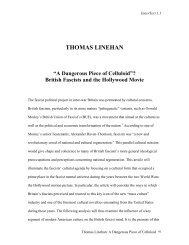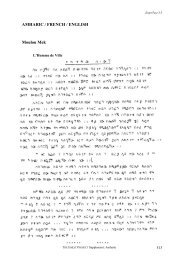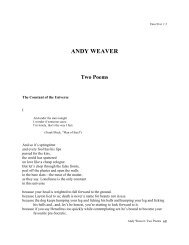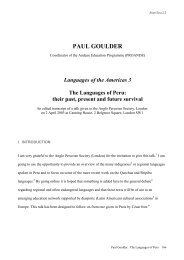Thomas Lamarre: An Introduction to Otaku Movement - Arts @ Brunel
Thomas Lamarre: An Introduction to Otaku Movement - Arts @ Brunel
Thomas Lamarre: An Introduction to Otaku Movement - Arts @ Brunel
Create successful ePaper yourself
Turn your PDF publications into a flip-book with our unique Google optimized e-Paper software.
EnterText 4.1<br />
regressive, a world full of activities and cultural movement but effectively at a standstill.<br />
Is this what otaku movement does?<br />
Fan culture analysis has taken issue with Adorno’s recourse <strong>to</strong> high modernism<br />
(his elitism) and with his sense of the passivity of the receiver of mass culture. In<br />
contrast, fan culture analysis has proposed <strong>to</strong> follow fandom closely and seriously, <strong>to</strong><br />
explore the activity of fans, without what is seen as Adorno’s bias against mass culture.<br />
Crucial <strong>to</strong> this shift are fans like the otaku—so-called cult fans. Matt Hills, for instance,<br />
distinguishes between fandom and cult fandom: while fandom and cult fandom appear <strong>to</strong><br />
overlap, cult fandom does seem <strong>to</strong> imply an identity that is at least partially distinct from<br />
the general fan—which is <strong>to</strong> say, not all viewers who like a certain TV series become cult<br />
fans of it. Hills suggests that this distinction between fans and cult fans “relates not <strong>to</strong> the<br />
intensity, social organization or semiotic/material productivity of the fandom concerned,<br />
but rather <strong>to</strong> its duration, especially in the absence of ‘new’ or official material in the<br />
originating medium.” 27 Which is <strong>to</strong> say, cult fandom perseveres in the absence of official<br />
production. If the cult fan demonstrates a kind of au<strong>to</strong>nomy, it is because the cult fan’s<br />
activity continues independently of the industry rather than simply following it actively.<br />
Hills’ work is indicative of a turn in fan culture analysis that looks <strong>to</strong> the ways in which<br />
the cult fan becomes akin <strong>to</strong> a producer of culture and thus somewhat au<strong>to</strong>nomous of<br />
official production—of the culture industry, as it were.<br />
As a cult fan film about cult fans (otaku), <strong>Otaku</strong> no Video poses the question of<br />
au<strong>to</strong>nomy within consumerism in a new way. Naturally, as a cult fan film about cult fans,<br />
it does risk the self-referential reification, even as it claims <strong>to</strong> transform the consumer<br />
in<strong>to</strong> a co-producer of culture. Yet <strong>Otaku</strong> no Video raises the intensity (and duration) of<br />
<strong>Thomas</strong> <strong>Lamarre</strong>: <strong>Otaku</strong> <strong>Movement</strong> 172










